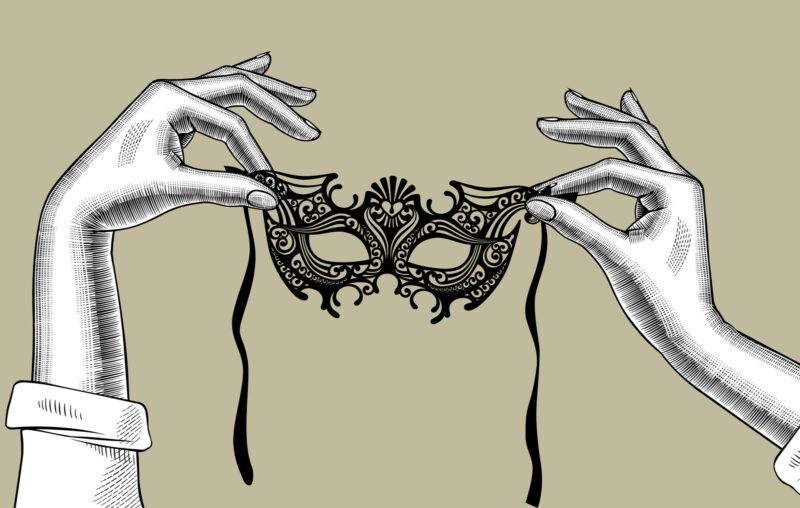Adele Spitzeder, the Queen of Confidence Tricksters

Adele Spitzeder (1832-1895) was active in Bavaria from 1869 to 1872. She operated what may have been the first Ponzi scheme in history. Spitzeder had retired from a successful and lucrative acting career, but continued to enjoy a luxurious lifestyle, and since she was no longer performing, she also had more time to indulge in extravagance. She had already fled debt collectors in Hamburg and Zürich. She received a modest allowance from her mother, but this was not adequate to support her household in expensive hotels, which included her girlfriend, multiple servants, and six dogs.
Late in 1869, Spitzeder met a working-class woman who apparently became her first victim. After gaining the woman’s confidence, Spitzeder wove the enticing tale of a foolproof investment opportunity that would pay 10 percent every month—probably a totally spontaneous lie. The woman gave Spitzeder 100 gulden to invest, and a few days later Spitzeder returned 20 gulden, promising a further 110 gulden after three months. Favorable word-of-mouth spread throughout Münich’s working-class communities, with the result that ever-widening circles of new victim-investors gave her their savings—something which must occur for a Ponzi scheme to continue. She founded the Dachauer Bank by the end of the year. Spitzeder initially advertised in Bavaria’s largest paper, the Münchner Neueste Nachrichten, offering 10 percent interest after sixty days on 150 gulden deposits, though before long there was no need to advertise. Anti-Semitism played a major role in the Dachauer Bank’s rise, because many poor and less-educated Christians mistrusted Bavaria’s purportedly Jewish-dominated banking establishment.
The Dachauer Bank’s business practices were unconventional to the point of being chaotic, as Spitzeder had no formal training in accounting. This is typical for a Ponzi scheme, where any semblance of sound business practice is merely a front to help conceal the theft. Spitzeder typically kept the money deposited by her victims in cupboards in her rooms or in sacks stacked on the floor. Accounting was limited to recording depositors’ names and the amount received from them.
In October 1871, her banking operations became too disruptive and she was asked to leave her hotel. Spitzeder took 54,000 gulden of her customers’ money and purchased a substantial townhouse at 9 Schönfeld Street near Münich’s largest park, the Englischer Garten. Including bank employees, almost one hundred people now worked out of her house, many of whom were not actual employees but free-lance brokers she paid commissions of between 5-6 percent on any deposits they brought in. She soon expanded into real estate speculation, buying 17 houses in prime Münich locations and other properties throughout Bavaria.
The Bavarian government had been looking for a legal pretext to close Spitzeder’s bank, but this was difficult since she always paid requested withdrawals promptly. The only regulatory constraint Münich authorities were able to apply was to classify her as a “Bankier 2. Klasse” (“second class banker”) and require her to register with the city for tax purposes, analogous to filing articles of incorporation. The Dachauer Bank had simply ignored this legal formality until 1872. Once the Dachauer Bank was compelled to register it was required to observe conventional accounting rules, which would have highlighted the fraudulent nature of the Ponzi scheme, but it does not appear this ever happened.
Spitzeder sidestepped the accounting requirement by simply ending the bank’s lending activities. This was actually not too difficult because what little lending Spitzeder ever did was never more than a front to make her bank appear legitimate—and after 1872 she focused solely on taking in more money from victim-depositors. As a result, the Ponzi scheme continued without interruption. Spitzeder was able to ignore the official ban on lending through a fairly sophisticated legal fiction, allowing Bank employees to lend directly to customers. Access to the Bank’s funds enabled some of Spitzeder’s employees to amass small fortunes of their own. For example, Franz Wagner, a clerk the Bank paid 60 gulden each month, earned enough through lending the Bank’s funds that he was able to purchase a house for 59,000 gulden.
The Dachauer Bank’s high interest rates drew deposits away from Bavaria’s legitimate banks, especially the Sparkassen or savings banks, to the point where it threatened their survival. Spitzeder appeared to be providing an alternative and higher-yielding savings instrument which competed directly with more conventional, lower-yielding savings accounts offered by the Sparkassen. As with any Ponzi scheme, it was easy for Spitzeder to pretend to pay higher interest when she was actually stealing all the principal. By May 1871, the Münich Sparkasse had already lost 50,000 gulden in deposits to the Dachauer Bank.
In the fall of 1872, the Bavarian Interior Minister advised the king that the Sparkasse Altötting was facing insolvency because so many of its depositors were moving their money to Spitzeder’s Bank. On October 29, 1872 the presiding minister for Upper Bavaria reported that unusually high withdrawals might require the Sparkasse Ingolstadt to call in loans early, which would have ripple effects throughout the economy. The Sparkasse Traunstein and the Sparkasse Mühldorf also reported extraordinarily large withdrawals which threatened their solvency.
In response, on October 30 and November 5, the Interior Ministry placed ads in newspapers throughout the kingdom warning customers not to invest with Spitzeder. Unfortunately this turned out to be counterproductive, because it made it appear that the government wanted to deprive the common people of an opportunity to earn higher interest. On November 7, 1872 the Münich police commissioner also issued a statement denouncing the bank’s fundamental unsoundness, which further amplified that impression. For many of Spitzeder’s financially unsophisticated victim-depositors, this campaign was more effective than any advertising she could have purchased.
She also helped feed Münich’s poor and homeless, opening 12 soup kitchens. Though financed with stolen money, her philanthropic initiatives reinforced her public image. She was widely applauded as an angel of the poor and her charitable work and pious demeanor elicited support from the clergy, an otherwise conservative quarter which would naturally have been skeptical. Catholic support provided new victim-depositors while partially shielding her from criticism and muting government and press scrutiny.
Spitzeder’s extravagant showmanship gained her favorable press. The main exception was Münich’s leading daily paper, the liberal Münchner Neueste Nachrichten, where she had initially advertised. By 1870 the Nachrichten routinely referred to Spitzeder as a fraudster until her bank collapsed and they were proven right. In reaction to these attacks, she took out ads in all of the Nachrichten’s competitors. She challenged her critics to prove she solicited deposits or that her depositors were being harmed in any way.
Spitzeder apparently tried to bribe Nachrichten editor August Napoleon Vecchioni in exchange for less critical coverage. When this strategy proved ineffective Spitzeder turned her attention to the Nachrichten’s main rival, the Volksbote für den Bürger und Landmann, an established Catholic-conservative paper with a circulation roughly comparable to the Nachrichten’s. The Volksbote was operating in debt, but Spitzeder was delighted to remedy this with a loan of 13,000 gulden. Thereafter, the Volksbote reliably took their patroness’s side in response to every criticism from the Nachrichten. Channeling the disgracefully widespread anti-Semitism of the time, other Catholic newspapers, especially Johann de Baptist Sigl’s Das Bayerische Vaterland, often denounced any criticism of Spitzeder as the pernicious efforts of “Jewish capital” to suppress the works of a pious and public-spirited Christian woman.
Starting in 1871, Spitzeder began seizing newspapers that had borrowed from her, acquiring a press empire that included the Extrablatt, the Neue Freie Volkszeitung, and the Süddeutscher Telegraph, ensuring those papers only gave her good press, if not actually serving as a marketing arm for her fraud. She also founded her own paper, the Müncherer Tageblatt, and made a 14,000 gulden loan to the Freier Landesboten. In return for the loan, Freier Landesboten publisher Theophil Bösl promised not to report negatively. The Landesboten’s extravagantly positive coverage gained her new victim-depositors from across Bavaria.
In November 1872, withdrawals exceeded new deposits for the first time. Because a Ponzi scheme grows exponentially, this must always occur at some point. Spitzeder responded by limiting withdrawals, processing them only for one hour daily between six and seven AM, and not allowing withdrawals on Saturdays or Wednesdays. Limiting withdrawals in any way usually signals that a Ponzi scheme is about to collapse. Next, the Münich police persuaded forty depositors to present claims in the city’s district court, which responded by ordering a review of the bank’s books. Ultimately this would prove fatal to the Dachauer Bank, which never kept any meaningful records.
On November 12, 1872, a court-appointed five-person commission of inquiry arrived at Spitzeder’s house to perform the court-ordered review. At about the same time competing banks organized a further group of 60 depositors who demanded immediate withdrawal of all of their money. These withdrawals exceeded Spitzeder’s cash on hand, leading directly to the bank’s collapse.
During the existence of the Dachauer Bank, Spitzeder stole 38 million gulden from 32,000 victim-depositors, an amount equivalent to more than 400 million euro or $430 million today. Forensic examiners were only able to recover 15 percent of the bank’s outstanding deposits. Waves of suicides followed.
In July 1873 she was sentenced to a mere three years and ten months for fraudulent bankruptcy in what was probably the largest fraud in history up to that time. The Dachauer Bank’s activities did not meet the rather technical definition of fraud under Bavarian law, so she was not convicted of fraud. Spitzeder remained brazenly unrepentant at her trial, maintaining that her unorthodox business was completely legal.
She wrote her memoirs in prison while her health deteriorated. The same newspapers that formerly championed her now made belated amends by publishing exposés and denunciations. However, among her victims were those who continued to support her despite their losses. She was released on September 9, 1876. Spitzeder then spent ten months in a Baden sanatorium, often surrounded by adoring fans, for whom she composed and performed at the piano. Her notoriety was still something of an asset, and in Berlin theatergoers awaited with anticipation to see the celebrated, or infamous, fraudster. Unfortunately, the police in Berlin and Vienna prevented her from performing.
Now that she could no longer perform under her own name, she adopted her mother’s maiden name, performing under the stage name Adele Vio. She published the memoirs she had written in prison, as Geschichte meines Lebens (The Story of my Life, Spitzeder 1878). Spitzeder also started issuing promissory notes, possibly to cover her living expenses. These notes contained an explicit warning that the issuer offered no security and that the creditors waived reimbursement if she was unable to repay the notes. On February 13, 1880, she was arrested with Marie Riedmayer, who had been her nurse and companion since her release from prison. However, prosecutors decided there was little they could do to protect anyone who was still willing to give her their money, and she was released.
For the rest of her life she lived off the charity of benefactors and a modest monthly allowance of 50 gulden she still received from her mother. New swindles resulted in prosecution and brief incarcerations, but her glory days on the stage and as a confidence trickster had passed. Spitzeder died in Münich on October 27, 1895 at the age of 63, largely forgotten.










